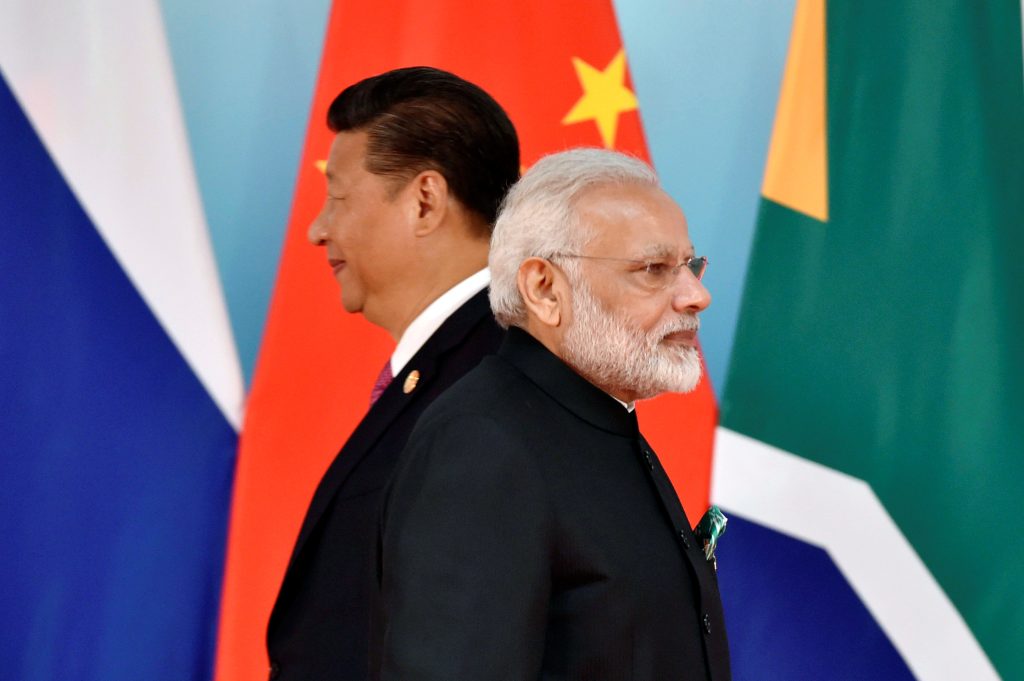China and India are at odds over BRICS expansion
China and India are at odds over BRICS expansion Atlantic Council


BRICS: Competing Visions for the Future
The rise of BRICS
Since its founding more than a decade ago, the BRICS group (Brazil, Russia, India, China, and South Africa) has grown substantially in stature as a forum to articulate the views of countries in the Global South in their dealings with developed countries. The group could evolve to become a counterpart to the Group of Seven (G7) in world affairs, resulting in a profound impact on international relations. But whether this impact turns out to be positive or negative will depend on which country’s vision for the BRICS forum’s future ultimately prevails: India’s or China’s. The two countries have vastly different ideas about how the group should move forward, as India’s disagreement with China’s push to rapidly expand the organization’s membership in the lead-up to the August 22-24 BRICS summit in Johannesburg, South Africa, demonstrates.
If the BRICS group follows India’s approach, then it can promote cooperation among developing countries and, on that basis, engage with the G7 to discuss ways to reform the international economic and financial system and deal with global problems such as the impacts of climate change. This would seem to appeal to many developing countries, which want to reform the current international economic and financial system but do not want to explicitly take sides between the United States and China. On the other hand, if China prevails, the BRICS group will likely become another venue for anti-US political activism, probably risking its ability to deliver concrete benefits to many developing countries.
Given this backdrop, it is important for the G7 to develop an effective approach to the evolution of BRICS—finding ways to engage with its constructive proposals to seek common solutions to global problems, while pushing back against its negative tendencies.
Competing visions
The BRICS group has revealed its internal divisions, however, as the rivalry between China and the United States has intensified. India has tried to resist China’s efforts to turn the BRICS group into a support organization for China’s geopolitical agenda, such as promoting Beijing’s Belt and Road Initiative, its Global Development Initiative, and explicit anti-US rhetoric. Instead, India has focused BRICS discussions and activities on South-South economic and financial cooperation projects, initiatives to reduce global reliance on the US dollar-based international financial and payment system, and reforms of international financial institutions to give developing countries more voice and representation. South Africa seems to have followed this approach in formulating the theme for the upcoming summit: “BRICS and Africa: Partnership for Mutually Accelerated Growth, Sustainable Development, and Inclusive Multilateralism.” To reinforce its focus on Africa, South Africa has reportedly invited the leaders of all African countries to attend the summit.
China and India’s disagreement regarding membership expansion will shape the prospects of aspiring BRICS countries and the organization’s future. According to South African authorities, twenty-two countries have formally applied to join the BRICS group, and a similar number of countries have expressed their interest. While this has enhanced the group’s stature, it also poses a difficult problem for the organization: admitting too many new members risks diluting the BRICS group, making it ineffectual if it continues to operate on a consensus basis. China and Russia have wanted to quickly expand the BRICS group to strengthen their influence in important developing countries—many of which also see the organization as an opportunity to get closer to China economically. India, on the other hand, is concerned about losing its own influence if the BRICS group admits too many new members closely aligned with China’s agenda. After all, India has had a persistently bitter border dispute with China, as well as a rivalry with Beijing for regional influence. Against this backdrop, India has proposed to discuss and agree on the criteria for membership—as an item on the August summit agenda—before admitting new members.
An effective G7 approach
Confronted with the efforts of several countries in the Global South to establish a forum—likely to be based on the BRICS format—to coordinate their views and policies to deal with the developed countries, the G7 should find an effective approach to manage its interactions with the BRICS group. If the BRICS group follows India’s agenda and comes up with concrete ideas to reform the international economic and financial system, the G7 should engage constructively and discuss in earnest those ideas—and not dismiss out of hand the demands for changes. However, if the BRICS group turns out to be a China-driven forum sponsoring anti-US and anti-West rhetoric and initiatives, then the G7 should push back against those criticisms—most effectively by suggesting ways to improve the current economic and financial system to address the shortcomings in meeting the development needs of countries in the Global South.
In any event, the BRICS forum is an idea whose time has come, and the world should be prepared to interact with it.
Hung Tran is a nonresident senior fellow at the Atlantic Council’s GeoEconomics Center, a former executive managing director at the Institute of International Finance and former deputy director at the International Monetary Fund.
Further reading
- How China would like to reshape international economic institutions
- What the Lula-Xi partnership means for the world
Image: Chinese President Xi Jinping (L) and Indian Prime Minister Narendra Modi attend the group photo session during the BRICS Summit at the Xiamen International Conference and Exhibition Center in Xiamen, southeastern China’s Fujian Province, China September 4, 2017.
SDGs, Targets, and Indicators
SDGs, Targets, and Indicators
- SDG 10: Reduced Inequalities
- Target 10.1: By 2030, progressively achieve and sustain income growth of the bottom 40 percent of the population at a rate higher than the national average.
- Indicator: The article mentions that BRICS countries get only 15 percent of the voting power at the International Monetary Fund, which indicates a lack of representation and potential inequality in the governance of international financial institutions.
- SDG 16: Peace, Justice, and Strong Institutions
- Target 16.7: Ensure responsive, inclusive, participatory, and representative decision-making at all levels.
- Indicator: The article discusses the differing visions of India and China for the future of the BRICS group, highlighting the need for inclusive and representative decision-making within the organization.
- SDG 17: Partnerships for the Goals
- Target 17.16: Enhance the global partnership for sustainable development, complemented by multi-stakeholder partnerships that mobilize and share knowledge, expertise, technology, and financial resources.
- Indicator: The article emphasizes the importance of the G7 developing an effective approach to engage with the BRICS group’s constructive proposals and ideas for reforming the international economic and financial system, indicating the need for partnerships and knowledge-sharing between these groups.
Table: SDGs, Targets, and Indicators
| SDGs | Targets | Indicators |
|---|---|---|
| SDG 10: Reduced Inequalities | Target 10.1: By 2030, progressively achieve and sustain income growth of the bottom 40 percent of the population at a rate higher than the national average. | The article mentions that BRICS countries get only 15 percent of the voting power at the International Monetary Fund, indicating a lack of representation and potential inequality in the governance of international financial institutions. |
| SDG 16: Peace, Justice, and Strong Institutions | Target 16.7: Ensure responsive, inclusive, participatory, and representative decision-making at all levels. | The article discusses the differing visions of India and China for the future of the BRICS group, highlighting the need for inclusive and representative decision-making within the organization. |
| SDG 17: Partnerships for the Goals | Target 17.16: Enhance the global partnership for sustainable development, complemented by multi-stakeholder partnerships that mobilize and share knowledge, expertise, technology, and financial resources. | The article emphasizes the importance of the G7 developing an effective approach to engage with the BRICS group’s constructive proposals and ideas for reforming the international economic and financial system, indicating the need for partnerships and knowledge-sharing between these groups. |
Behold! This splendid article springs forth from the wellspring of knowledge, shaped by a wondrous proprietary AI technology that delved into a vast ocean of data, illuminating the path towards the Sustainable Development Goals. Remember that all rights are reserved by SDG Investors LLC, empowering us to champion progress together.
Source: atlanticcouncil.org

Join us, as fellow seekers of change, on a transformative journey at https://sdgtalks.ai/welcome, where you can become a member and actively contribute to shaping a brighter future.








